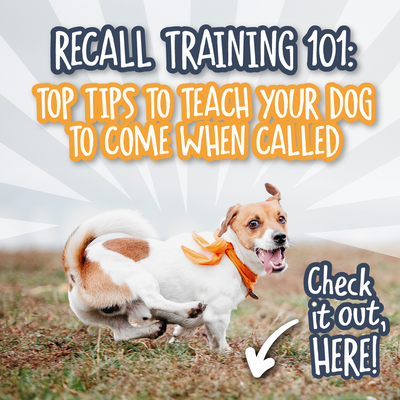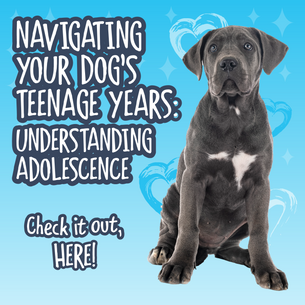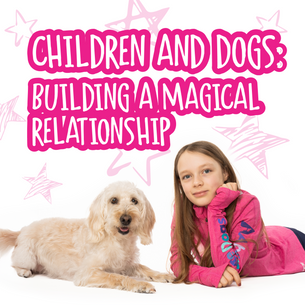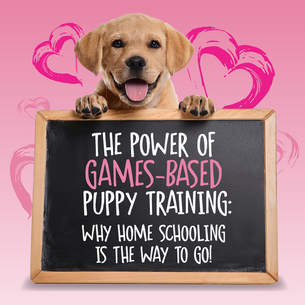Do you have a dog that refuses to come when called, chases distractions and ignores you when out and about, or won’t come back at the end of an off-leash walk? You are in exactly the right place. At Absolute Dogs, we understand the challenges that a lack of recall can cause for you and your dog!
It’s not uncommon for a dog to become so engrossed in their surroundings that they ignore your cues and calls. This can be particularly frustrating and concerning, and can have a massive impact on the relationships of dogs and their owners, often restricting dogs to a life on lead.
We know that having a rock-solid, reliable recall is one of the most common struggles faced by many dog owners all over the world – especially in challenging environments where distractions are all around – but we also know how easy (and fun) a reliable recall is to train with any dog (no matter their age, breed or training history)!
In this blog, we’ll cover everything you need to know about dog recall training. We’re bringing you top tips on how to get your dog to come to you, and how to get your dog to listen when distracted. You'll also learn practical strategies to address common issues, such as a dog that won't come when called outside, and discover how to make recall training a positive and successful experience for both you and your dog.
Teaching Your Dog to Come When Called: The Importance of Recall Training
A rock-solid recall is more than just a convenience; it's a critical component of their safety. A strong recall can prevent accidents, keep your dog away from dangerous situations, and ensure they return to you quickly and safely. Recall training also has the additional value of boosting your bond and creating a stronger relationship between you and your dog.
Teaching your dog to come when called is a vital skill for any dog owner. Whether your dog runs away and won't come when called, or your dog won't come inside from the garden, reliable recall training can significantly enhance your dog's safety and your peace of mind, and it’s essential to address these challenges with patience and effective strategies.
5 Top Tips to Train Your Dog to Come When Called
Achieving a reliable recall is one of the most rewarding aspects of dog training. It's not just about safety — though that's a crucial part — but also about building a deeper connection with your dog and ensuring they have the freedom to explore while still listening to you. In this section, we'll explore our top techniques and strategies to teach your dog to come when called, even in the most distracting environments.
TIP #1: Use high-value rewards and play dog training games: Unleash the power of positive reinforcement and uncover your dog's reinforcement preferences! Whether it's food, play, or praise, you can tailor your recall to what your dog loves the most (not what you think they should love).
Just as high-value rewards can make a significant difference in your recall training, incorporating training games and playful strategies such as those we play in our Games Club will help you make learning recall a fun and engaging activity for your dog.
If you can encourage your dog to return to you with a deal they can't resist, and grow their desire to stay close to you, you'll make every recall a joy-filled, positive experience (for both you and your dog)!
TIP #2: Stay calm in recall mishaps and avoid chasing your dog: If your chosen recall strategy doesn't work on any given day, switch it up! It's important to have many recall strategies and approaches in your toolkit to mix and match and find what truly clicks with your dog for a successful recall every time!
TIP #3: Practise on-leash recalls: Training on lead, in low distraction areas, helps grow your dog's value in sticking close to you while allowing you to set your dog up for success. Having your leash or long line attached to your dog as backup also prevents your dog from bolting, making poor choices or disengaging from you.
TIP #4: Embrace play and unpredictability: Keep your dog engaged and eager to come back to you by offering diverse recall experiences they can't predict! Play hide and seek to level up your dog's recall skills!
Make it as easy or as challenging as your dog needs and create a positive, rewarding experience as they seek you out using their keen senses! This is not only great for recall training, it also provides your dog with enrichment opportunities that engage their brain and their body.
TIP #5: It's not just your training sessions that matter: It's important to remember that a 24/7 approach to shaping your dog's behaviour and celebrating their awesome decisions every day is key to teaching them reliable life skills such as recall, calmness, disengagement, focus and so much more.
BONUS TIP: Learn when to call and when to take action: You don't want to call your dog or try your new recall cue in a situation where you know your dog won't respond. If you aren't 100% sure your dog will listen, then it's not worth poisoning your training progress by attempting to recall them, especially in the early stages.
Instead, you can take action by going to get your dog in a calm manner, popping them back on lead and working to prevent mishaps in future by keeping your dog on leash when out and about, and using a long line when you want to give them more freedom while having the security of being able to reel them back in if they wander too far.
By following these top tips, as you work on training your dog to come when called, you'll be well on your way to ensuring a responsive and reliable recall while building trust with your dog for the ultimate rapid recall!
3 Expert Strategies to Teach Your Dog a Reliable Recall
When it comes to effective recall training for dogs, there are some essential elements and fundamental skills that help you to create a dog who is reliable and attentive off lead, resulting in stress-free walks for you and your dog.
#1: Practise Recall Training Regularly and with Consistency
Regular practice and training top-ups are essential for teaching your dog to reliably come when called. Short, frequent training sessions are more effective than long, occasional ones, so keep your dog engaged and make recall training a part of your daily routine.
#2: Practise Teaching Recall in Controlled Environments
When it comes to successful recall training for any dog, gradual exposure to distractions, and working in environments that your dog can handle are both key elements to consider.
Start training in a low-distraction environment like inside your home, before moving to somewhere slightly more distracting, like your garden or driveway. Gradually increase the level of distraction as your dog becomes more reliable. This method helps your dog learn to focus on you, even when there are other exciting things happening around them.
As your dog improves, you can begin introducing them to more challenging environments. You can try starting with an empty or quiet car park or industrial estate, before moving to a friend's garden or a quiet park. Only move to busier areas when you are 100% certain your dog has the skills to handle them, and always ensure you can still manage your dog by using a longline or puppy line.
#3: Choose a Clear Recall Command and Reward Every Time
The golden rule in recall training, and another key to success, is deciding on a distinct recall cue that is easy for you to remember, easier to say and even easier for your dog to recognise. Your recall cue can be anything from a word, a particular sound that you make such as a tongue roll or trill, or even a specific whistle for dog recall.
It is absolutely critical that you also avoid overusing your chosen recall cue. It should only be used when you’re sure your dog will respond, or you can guide them back to you. If your cue gets overused without a successful recall, it becomes less effective and can even be poisoned if it is simply used too much, so consistency is key when it comes to training and ensuring everyone in your household or those that care for your dog use the same recall command.
In the initial stages of training, it’s also vital that you reward your dog every time they come to you, whether they seek you out at home, choose to check in without prompting on a walk, or even if they get distracted mid-recall and it takes a while for them to come back.
Reinforcing your dog every time they choose to come to you or respond to your call – and topping up by rewarding regularly even after they have a reliable recall – helps your dog pair coming to you with good things happening and ensures their recall is always a positive experience.
Troubleshooting Why Your Dog Won’t Come When Called
If your dog doesn't come when called outside, it's often because the environment is more stimulating than the rewards you offer. Whether you’re out and about on walks or hikes, or you’re simply trying to get them to come inside from the garden, learning how to get your dog's attention when distracted is crucial.
When out and about, try increasing the value of your rewards or use a more enticing toy. You can also use high-value treats and practise low-distraction areas, before gradually moving to more distracting environments – all while keeping training sessions short and fun.
When trying to get your dog to come inside from the garden, you can try making the inside environment more appealing. Use high-value treats, toys, and praise whenever they do come inside.
It’s also important to avoid making coming inside (or popping a lead back on at the end of a walk) a signal that fun is over. You can occasionally pop their lead on or call them inside, and then continue your walk or invite them in just to play or get a treat, before letting them go again.
DID YOU KNOW?
A whistle can be more effective than your voice because it’s consistent and can be heard over long distances. A whistle recall can be particularly effective because it sounds the same no matter who is blowing it.
Whistle Recall training is another layer you can introduce for dogs of any age, breed or training stage to help create a fun and varied experience that will make your dog excited to respond, anytime, anywhere!
Teaching your dog to come when called is a journey that requires patience, consistency, and the right techniques. By using a long line lead, incorporating high-value rewards, and practising in controlled environments, you can build a reliable recall.
Remember, the goal is to make coming to you the best deal for your dog, even when there are distractions. With these top tips for dog recall training, you'll have a well-trained dog that comes when called, ensuring their safety and your peace of mind.
If you want to dive even deeper into building a real-life, reliable recall for your dog, check out our Total Recall programme, packed with 30 targeted recall games and strategies that can all be played in under 1 minute and are designed to make recall training fun, quick, and totally effective for you and your dog.




